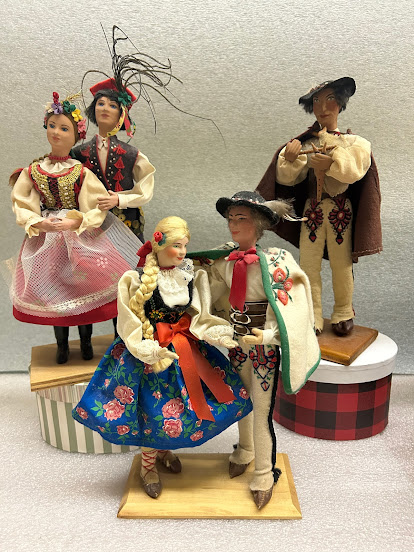by Monica Groth, Curator
 |
| Polish Dolls Courtesy of Jackie Droleski |
In 1983, the Chemung Valley History Museum's Bank Gallery was filled with dancers costumed in bright boots, flower crowns, and intricately embroidered vests.
.jpg) |
| The Tatra Dancers at CVHM, 1983 |
That day, the Tatra Dancers, a Polish folk dancing group, performed at the Museum before an excited audience.
.jpg) |
| The Tatra Dancers at CVHM, 1983 |
The Tatra Dancers had been established as a club just seven years earlier with the encouragement of two local Polish cultural organizations: the White Eagle Society and the Polish Arts Club. These organizations were on a mission to revive interest in and appreciation for Polish art and culture among second and third generation Polish-Americans who were losing knowledge of their heritage.
Polish immigration to Chemung County peaked in the late 19th century. Many immigrants had settled in the coal mining districts of northern Pennsylvania in the decades prior to 1900, but came to Chemung County when jobs in industrializing Elmira and Elmira Heights offered better economic opportunities. Organizations were immediately created to keep Polish culture alive. The earliest Polish organizations were founded through St. Casimir's Church, established in 1890 as the center of the Polish Catholic community. The St. Casimir's Society was founded in 1895, and the White Eagle's Society (which still thrives today and is part of the Polish National Alliance) was established in 1907. The societies generated income for members' sick/death benefits and hosted events within the community. Through the decades, Polish music and language were promoted at St. Casimir's church services and Polish-language classes were taught at St. Casimir's parochial school, run by the Polish-speaking Sisters of St. Joseph.
 |
| St. Casimir's Church, c. 1890. Image Courtesy of Jackie Droleski. |
 |
| St. Casimir's Church, 2002. A large brick structure was built to replace the original wood-frame church in 1912. The Church stands at 1000 Davis St., Elmira today. |
Over time, however, as Polish-Americans increasingly assimilated into multicultural America, the use of Polish language in church, school, and clubs decreased, nearly disappearing by the early 1950s.
 |
| Minutes of Council 104 of the Polish National Alliance taken in Elmira, NY 1954-1955. The book is open to the entry where records switch from Polish to English. |
In the early 1970's, the community experienced a cultural Renaissance, as parishioners of St. Casimir's reinitiated Polish music and language in Masses. A new Polish Choir was assembled and the Polish Arts Club was formed in 1973. The Club hosted language and crafts classes as well as lecture and film series on Polish culture.
As part of this Renaissance, the Tatra Dancers were established in 1976. The name Tatra comes from the name of the Western Carpathian mountain region of Poland where many folk dances originated.
 |
| The Tatra Dancers Image from Elmira's Poles by Ray Winieski |
The group learned and performed traditional Polish folk dances and were dedicated to authenticity. Group instructor George Bacmanski supplied the group with traditional costumes directly from Poland. In 1979, his daughter Rose Bacmanski studied at Poland's Koscuiszko Foundation, and in 1980, the group traveled to Poland to perform in the Rzeszow Folk Festival.
 |
| Embroidered woolen vest made in Poland and believed to have been worn by a Tatra dancer Loaned courtesy of Marge Cowulich |
There are many different styles of Polish folk dance, each deriving from the distinct culture of the region in which it originated. However, the so-called "national" dances spread throughout the country from their original regions and were danced by all classes.
The five national dances of Poland include:
The Krakowiak: a fast paced exhibition dance featuring several couples following a lead pair. It hails from the Krakow region of Poland.
The Kujawiak: a slow, smooth dance from the Mazovian plains region of Kujawy. The dance is usually paired with the faster Oberek.
The Oberek: a dance from the Mazowsze villages of Central Poland. Like many styles, the Oberek originated amongst peasants and spread to the nobility. It's name comes from the Polish word "to spin" or rotate and it is known for its jumps and spins.
The Mazur: another dance from the Mazovian plains, the mazur has a popular if irregular rhythm and much foot-stomping and heel-clicking.
The Polonez: the aristocratic waltz-like "walking" dance is a slow promenading ballroom dance
Popular regional dances from the Tatra region of Poland include the Goralski and the Zbojnicki, both known as highland dances. Both dances showcase the acrobatic talents of dancers and can use the ciupaga, or shepherd's axe, though the axe is more popular in the Zbojnicki, an all-male dance modeled after the exploits of the "zbojnik", or mythical robber, of the region.
Watch Polish dances being performed on this YouTube Playlist: https://www.youtube.com/playlist?list=PLR18vxeMSzPSBEsjhKAOkzbBmYM29axyn
 |
| Cup featuring the Kujawiak Courtesy of Christina Markiewicz |
 |
| Cup featuring the Mazur Courtesy of Christina Markiewicz |
 |
| Cup featuring the Polonez Courtesy of Christina Markiewicz |

No comments:
Post a Comment